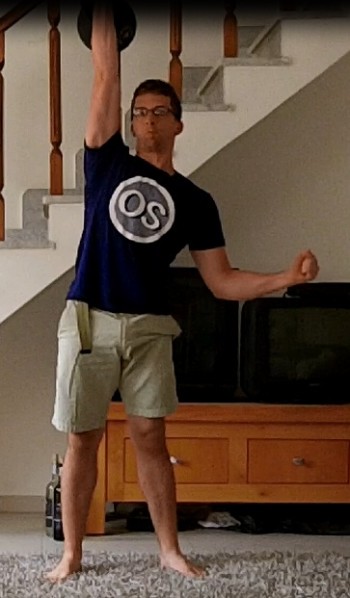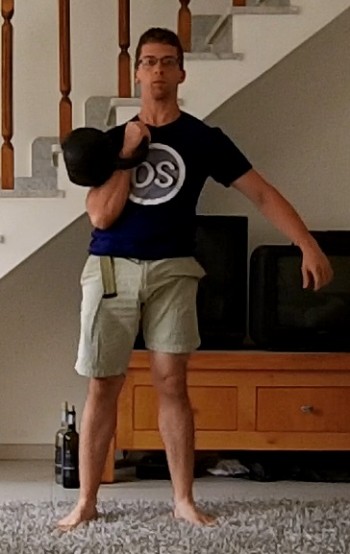Original Strength For Brute Strength
Jun 29, 2014
The following is a guest post by Original Strength Certified Coach, Aleks Salkin.By now it’s no surprise that Original Strength is the perfect answer to dissolving your aches, discomforts, tightness, and movement issues. But did you also know that it’s your sword and shield for use in epically crushing weakness?
Yeah, not just getting stronger, but straight up punching weakness right in its stupid face.
The secret?
There are two. And really, they’re not secrets. Just practices that you may not know about yet. Sorry if you were expecting some dark arts sort of stuff.
1) Utilizing resets between sets of any given exercise
2) Experimenting to find the right reset for the right exercise for YOU
The first is important because many relegate the resets to a warm-up or cool-down only and miss out on the benefits of doing them WITHIN their training, which can help you and your body figure out how the resets connect to various strength and athletic movements. Call that reset inception if you will, but it works like crazy.
The second is important because one size NEVER fits all if it’s something worth wearing. Don’t fall into that trap. In fact, you might find that what would seem to be the most obvious reset might not be the one that helps you the most.
Using the principles of Original Strength (crossing the midline and stimulating the vestibular system specifically) in tandem with the training principles found in StrongFirst leads to awesomely quick gains in strength and improvement in technique, regardless of the movement.
I recently spent the last few months training hard for my SFG II certification in Italy, and for those who know anything about it, they know that one of the biggest hurdles that candidates face – in addition to the various technique tests and that one must pass – is the half-bodyweight one-arm military press.
The approach many people take to it is to press and press and press some more – a good approach to improve pressing power, but one that overlooks the fact that in order to pass the cert, you must still pass your level one skills and the other level two skills, 9 of which are overhead (single snatch, double snatch, the snatch test, double military press, Turkish Get Up, windmill, bent press, push press, clean and jerk). That’s a lot of overhead work and it can lead to plenty of issues *IF* you’re adding more and more work on less and less of a rock-solid foundation. As Master SFG Dave Whitley recently said to me “I’m all about making hard stuff easier”, which is exactly what this article is about. It will be hard. You will have to train. But you can make it easier.
Here’s a short case study based on the most recent training of yours truly. I’ll spare you all the details of my training program and focus specifically on the military press and how I found the right reset FOR ME to improve it.
Here was my uber-scientific approach.
You ready?
I tried a reset and shortly thereafter would press my 32 kg bell (36 kg was the test weight). If the press got shakier/weaker, I knew it wasn’t for me. If the press got stronger, faster, and floated overhead with less struggle, I knew I was on the right track.
BOOM. Science.

I’ve talked to many people about improving their military press with OS resets, and there was one commonality they all shared: they crawled backward. A LOT. And if you think about it, that makes perfect sense: crawling backward – weighted or unweighted – recruits the “lead actors” of all pressing: the triceps, the chest, and the shoulders, as well as the best supporting actors of the abs, lats, and legs. Win-win, right?
Well, not for me. You read that right, crawling backward FOR ME was not the best reset to do between sets of presses. When I pressed, most often I found that my abs would try to check-out, leaving a very important component behind and torpedoing my press.
To fix this, I honed in on my obvious weakness: ab tension. I tried a set of dead bugs, and low and behold, my kettlebell stopped playing games and cooperated by manning its post high above my head without arguing. Later, due to the fact that I just didn’t want to lie down and stand up between every set, I would do standing cross-crawls instead, and it worked just as well (maybe better, given that it is a standing reset and the military press is a standing exercise).



The end result? My pressing got better and better, and my shoulders were happy enough to do everything I asked of them without hurting. This is due to a number of factors, but one of them was establishing a solid foundation for future gains by consistently adding reflexive stability to my strength skills.
Why does this work?
There are a bunch of reasons, I’m sure, but the big one that I noticed in this particular instance was this: tension = strength. We all know that. So whether it’s Original Strength or brute strength, some form of tension will be needed. In OS, it’s reflexive tension (i.e. reflexive stability – something your body produces without your conscious thought). In Hardstyle, its feed-forward tension (actively producing muscular tension to lift more weight). While both of these systems require different approaches to do properly, the net effect is the same: you get stronger. Think of reflexive tension and feed forward tension as light bulbs, and your body as a room. Which room will be brighter: a room with only one light bulb or a room with two?
Try this for yourself. It will work with anything. Pick a strength move of your choice and see what makes the biggest difference in your technique and ease of hoisting heavy objects. The obvious choice may not be the best. Find the reset that works best for you and watch as your strength soars. And when you do, drop me a line – I wanna hear about it.
Aleks Salkin is a level 2 StrongFirst-certified kettlebell instructor (SFG II), StrongFirst-certified bodyweight Instructor (SFB), and an Original Strength Certified Coach. He grew up scrawny, unathletic, weak, and goofy, until he was exposed to kettlebells and the teachings and methodology of Pavel in his early 20s. He is currently based out of Jerusalem, Israel and spends his time spreading the word of StrongFirst and calisthenics, and regularly writes about strength and health both on his website and as a guest author on other websites. Find him on Facebook at https://www.facebook.com/alekssalkintraining online at https://www.alekssalkin.com.
Comments (0)
Please login to comment.